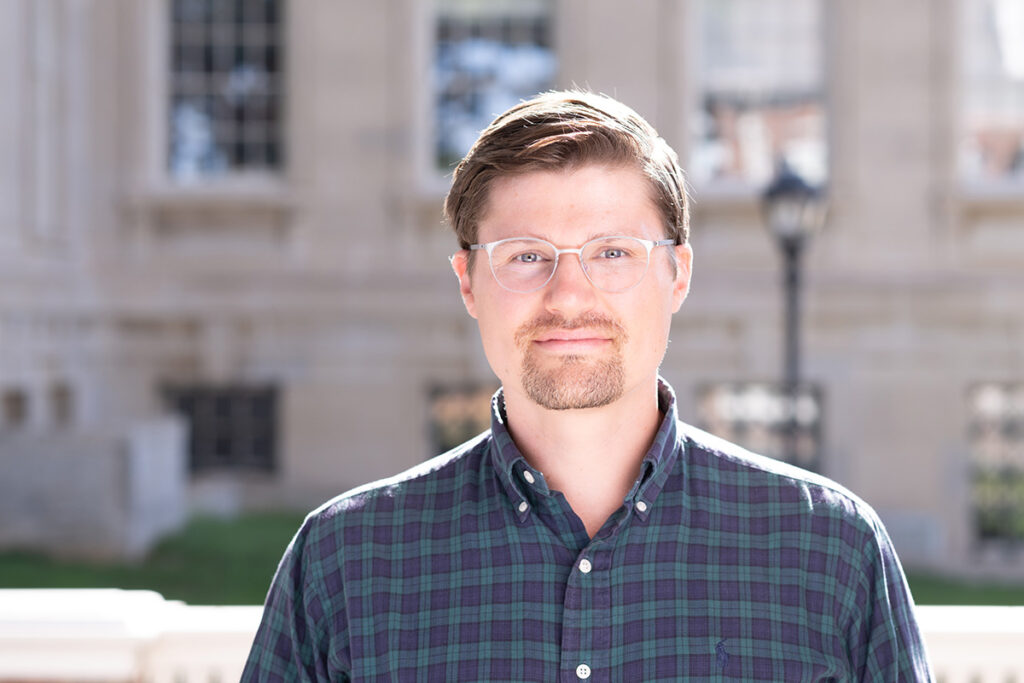Learn more about Robert Elliott ’11, assistant professor of civil and environmental engineering

Robert Elliott ’11 | Photo by Adam Atkinson
What I study and why: I study how to engineer and integrate natural systems with the built environment to improve safety, resilience, and sustainability. Living ecosystems have the potential to repair natural processes and solve developmental goals because of their 1) adaptability; 2) environmental performance; and 3) multidimensional benefits. I focus on urban settings because it is where environment regulating processes are most disrupted (e.g., heat island, stormwater runoff), and populations are most in need of the health and well-being benefits that nature can provide. Growing up in a Quaker family, I was raised to understand “there is no way to peace; peace is the way.” I believe the same is true about achieving harmony with nature, meaning it must be realized by designing in kinship with nature.
I love this challenge because of its intrinsic interdisciplinarity. From a natural science perspective, ecosystems are functional networks that emerge from abiotic factors and cross-domain life–needless to say, the actual web is beyond complex. The services that these ecosystems then provide can be viewed through multiple lenses, including environmental regulation (e.g., stormwater absorption, temperature reduction, water purification, food production), cultural impact (e.g., health, well-being, livability), and practical viability (e.g., CapEx, maintenance, NPS). I’ll stop there … but please reach out if any of this sounds interesting to you!
What I’m teaching this fall: This fall I’m teaching two courses in the Civil Engineering Department. First, Fluid Mechanics (CE 251) is a core engineering course where we explore the physics of how fluids behave at rest and in motion and learn how to apply this understanding to design. Second, CE Project Management (CE 331) is an upper-level course where we study how civil engineering projects (the biggest things humans have built) are practically realized and what management techniques can be applied to control the scope, cost, teams, and timeline of these large, expensive, and complex projects.
What students can expect from me: My goal is to help students develop their own motivation to apply engineering thinking and be equipped with the abilities and mindset to address the increasingly complex challenges of the modern world. They can expect me to push them in their technical skills and consider the broader environmental and human impacts of pure engineering decisions, which is something I’ve encountered in both my formal education and my professional practice. When I started a business after completing my Ph.D., I was comfortable tackling complex engineering problems but found myself underprepared for what was needed for these solutions to take hold in the real world. While the applied technology was critical to the function of our novel products, it quickly became clear that success also depended on complete financial models, careful project management, engineering economics, and strategic organizational design. I am excited to work with students on how to excel in functional, human-centered, and integrated engineering design alongside operational, time-management, and economic tools.
Getting to know me: Ask me to play squash! If that’s not your thing, I would love to grab a coffee. I love talking about design, gardening, food, and learning about all of the interesting projects happening at Lafayette. Outside of my teaching and research, I spend my free time with my wife, Sarah (also a Lafayette alum!), our 2-year-old daughter, Louisa, and our tri-pawed dog, Zuzu.
Continue reading to meet more of Lafayette’s newest faculty members.
